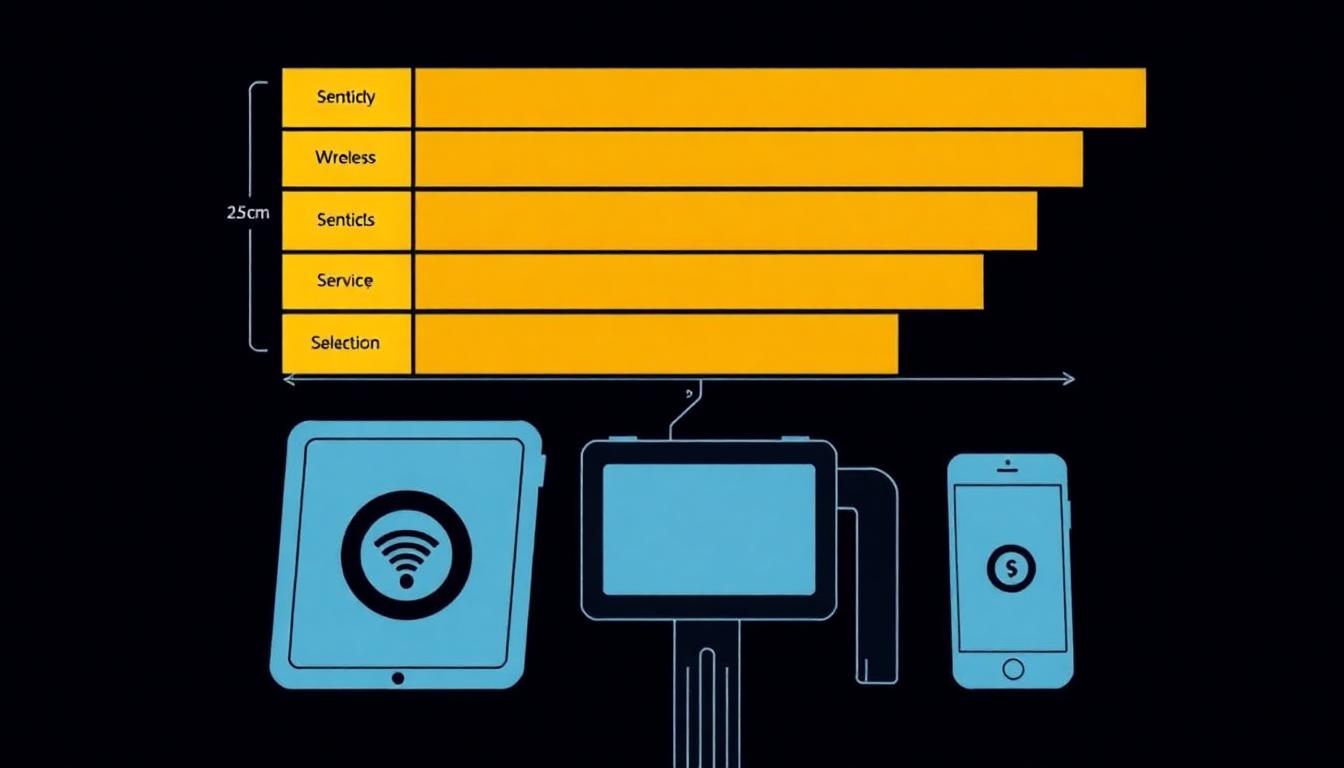The arrival of new wireless standards in 2025 promises to reshape the performance and capabilities of electronic devices across multiple sectors. These advancements will influence device design, connectivity, and power efficiency, affecting both manufacturers and end users alike. Understanding these changes is essential for IT professionals, developers, and businesses to adapt their strategies and ensure compatibility. This post will examine the technical progress and the broader consequences of these wireless standards as they become integral to device ecosystems “Emerging Wireless Standards Electronic”.
Overview of Emerging Wireless Standards in 2025
As wireless technology advances rapidly, 2025 stands out as a pivotal year for new standards shaping how electronic devices connect and communicate. The landscape will be dominated by refined 5G capabilities, the introduction of Wi-Fi 7, and the early stages of 6G research. These standards directly impact device performance, network efficiency, and user experience, presenting new opportunities and challenges across industries.
5G Evolution and Its Enhanced Capabilities
The initial rollout of 5G brought significant improvements over 4G, primarily around speed and latency. Now, the evolution of 5G, often referred to as 5G-Advanced, is pushing those boundaries further. This iteration focuses on:
- Faster speeds that can exceed initial expectations, supporting data-intensive applications and high-definition streaming seamlessly.
- Lower latency, approaching near real-time responsiveness, which benefits critical uses such as remote surgeries and autonomous vehicles.
- Broader coverage achieved through improved signal processing and higher efficiency in diverse environments, including urban and rural settings.
These enhancements also emphasize energy efficiency and AI-driven network automation, making networks smarter and more adaptive. Electronic devices built with this upgraded 5G will have longer battery life and better connectivity stability. This evolution ensures that devices will handle increasing data loads with greater reliability.
Learn more about the advancements in 5G and its implications in The State of 5G: Growth, Challenges, and Opportunities in 2025.
Wi-Fi 7: Next-Generation Wireless Connectivity
Wi-Fi 7 is set to redefine wireless connectivity within homes, offices, and public spaces. Its core features include:
- Higher throughput, potentially tripling current Wi-Fi 6 speeds, enabling faster file transfers and smoother streaming experiences.
- Improved efficiency in congested networks, minimizing interference and maintaining consistent performance even when multiple devices connect simultaneously.
- Enhanced multi-device support through better handling of simultaneous data streams, critical for smart homes and dense workplaces packed with IoT gadgets.
Additionally, Wi-Fi 7 introduces deterministic latency, which makes the connection more stable and predictable—crucial for applications like online gaming, AR/VR, and real-time collaboration tools. Devices designed to support Wi-Fi 7 will bring noticeable improvements in speed and responsiveness compared to previous generations.
For a deeper dive into Wi-Fi 7 capabilities, visit Wi-Fi CERTIFIED 7.
Early Developments in 6G Technology
Although 6G is still in its infancy, research initiatives are gaining momentum in 2025. Expected to launch approximately a decade from now, 6G aims to deliver:
- Ultra-low latency and extremely high bandwidth, far surpassing even 5G-Advanced benchmarks.
- Native integration of artificial intelligence within networks to automate management, security, and data processing.
- Enhanced support for new applications such as holographic communications, immersive virtual environments, and expansive IoT ecosystems.
Governments and industry leaders are collaborating widely to develop standards that address security, sustainability, and scalability. These early developments indicate the potential to revolutionize electronic devices’ connectivity and functional capabilities significantly.
More insights on 6G technology progress are available at 6G Technologies Market Analysis Report 2025-2030.

Photo by cottonbro studio
These emerging standards are setting new benchmarks for connectivity. Electronic devices equipped with these technologies will meet higher demands for speed, reliability, and smart functionality required in both personal and professional contexts. For more on the impact of connectivity advances on device ecosystems, see The Spartan’s article on wireless technology integration.
Impact on Electronic Devices and Design Considerations
The introduction of emerging wireless standards in 2025 is driving substantial changes in how electronic devices are designed and operate. These new protocols demand careful attention to hardware compatibility, energy consumption, and the ability to work across multiple networks without interruption. Electronic device manufacturers and developers must navigate these factors to meet modern connectivity expectations while maintaining performance and reliability.
Hardware Upgrades Required for Compatibility
Supporting the latest wireless standards requires significant hardware updates, notably in chipsets and antennas. These components are at the core of a device’s ability to communicate effectively with networks that employ advanced protocols like 5G-Advanced, Wi-Fi 7, and forthcoming 6G technologies.
New chipsets must handle more complex signal processing, higher frequency bands, and expanded bandwidth capacities. This often means integrating multi-band transceivers and enhanced digital baseband processors capable of rapid data handling and sophisticated error correction. Antenna design must also evolve to optimize signal reception and transmission across wider frequency ranges while reducing interference.
Key hardware considerations include:
- Advanced semiconductor materials for higher-speed processing and reduced heat generation.
- MIMO (Multiple Input Multiple Output) antenna arrays with beamforming capabilities for better range and stability.
- Miniaturization techniques that allow these components to fit into increasingly compact device profiles without compromising performance.
Upgrading these elements ensures devices remain backward-compatible with older networks while fully utilizing the speed and efficiency gains offered by new wireless standards.
Energy Efficiency and Battery Life Enhancements
One of the defining goals of new wireless standards is reducing power consumption without sacrificing performance. Devices built for 2025 must balance faster data rates with longer battery life, especially as mobile and IoT devices become more prevalent.
Wireless protocols achieve energy efficiency through several mechanisms:
- Optimized modulation schemes reduce the time needed to transmit data, thereby conserving power.
- Intelligent power management dynamically adjusts radio activity, turning off or throttling sections of the chipset during idle periods.
- Network-level enhancements allow devices to minimize signal retries and maintain connectivity with less overhead.
These improvements translate to measurable benefits: users can expect longer usage times between charges and devices that manage heat dissipation better, extending both comfort and hardware longevity.
Manufacturers increasingly focus on integrating low-power components and software-defined radios that are flexible enough to switch between standards without additional energy costs. Battery technology advances in tandem, with faster charging and higher capacity cells complementing these standards.
Interoperability Challenges and Solutions
Ensuring devices communicate seamlessly across various wireless standards presents a significant engineering challenge. Differences in protocols, frequency allocations, and network behaviors can lead to compatibility issues, dropped connections, or suboptimal performance.
Addressing these challenges involves:
- Multi-standard support: Devices must incorporate flexible chipsets capable of operating over a range of protocols like 4G LTE, 5G, Wi-Fi 6/7, and eventually 6G, allowing smooth hand-offs between networks.
- Unified software stacks: Maintaining consistent communication and session management across various radios requires sophisticated firmware and driver designs that abstract the underlying complexities.
- Testing and certification: Rigorous interoperability testing ensures devices meet standards across manufacturers and network providers, reducing user friction.
Companies adopt modular design approaches, allowing components to be upgraded or replaced without full device redesigns. The use of adaptive algorithms helps optimize connections even in mixed-standard environments, improving user experience regardless of network conditions.
To explore more on how wireless technology impacts device design, consider this analysis on wireless technology impact on device design.

Photo by Sound On
Opportunities and Challenges for Developers and Businesses
The evolution of wireless standards in 2025 opens a wide range of possibilities for developers and businesses, while also presenting distinct challenges they must address. These advanced wireless technologies enable new applications and services, but they require vigilance in security and strategic planning to gain an edge in an increasingly competitive market.
Innovative Applications Enabled by Advanced Wireless Technologies
Emerging wireless standards provide the backbone for technologies that enhance everyday life and business operations. Their improved speed, lower latency, and higher reliability unlock applications that were either impractical or impossible before.
Some notable opportunities include:
- Augmented Reality (AR) and Virtual Reality (VR): With lower latency and higher throughput, AR devices and VR headsets can deliver smooth, immersive experiences without lag. This supports industries like retail, education, and healthcare with realistic simulations and interactive environments.
- Expansion of Internet of Things (IoT): Advanced wireless connectivity supports a greater number of connected devices, improving smart home automation, industrial sensors, and logistics tracking. Reliable, fast connections are essential for seamless data exchange in these ecosystems.
- Development of Smart Cities: These standards help power city infrastructure including traffic management, environmental monitoring, and public safety systems. Real-time communication allows cities to operate efficiently while improving quality of life for residents.
These applications depend heavily on reliable connectivity, low latency, and broad coverage — all parameters that the new wireless standards aim to optimize. Developers can exploit these to build solutions that offer more responsiveness and wider scalability.
Security Implications and Best Practices
Alongside these opportunities come new security concerns. Increasing device density and data volume create a larger attack surface for cyber threats. Emerging wireless standards introduce complex protocols that, if not properly secured, could leave networks vulnerable.
Key security risks to consider:
- Increased Exposure: More connected devices increase points of entry for hackers. IoT devices often have limited security features, making them prime targets.
- Protocol Complexity: Advanced wireless technologies use intricate algorithms and frequency bands, which require updated security mechanisms. Outdated practices risk exploitation.
- Data Privacy Challenges: Higher data throughput and more frequent connections demand stringent encryption to protect user and organizational information.
To mitigate risks, businesses and developers should adopt these practices:
- Implement Strong Encryption: Use end-to-end encryption methods compatible with new wireless protocols.
- Regular Firmware and Software Updates: Keep devices’ communications modules up to date to patch vulnerabilities quickly.
- Network Segmentation: Isolate IoT and operational networks from core business systems to limit damage from breaches.
- Zero Trust Architecture: Continuously verify users and devices attempting to access resources regardless of their location.
Staying informed on security standards related to emerging wireless technologies is essential to protect both users and infrastructure from threats.
Market Dynamics and Competitive Advantage
Early adoption of emerging wireless standards can create a significant competitive edge for companies, driven by improved service delivery, operational efficiency, and product innovation. However, entering too soon or without proper strategy may increase costs and lead to integration challenges.
Considerations influencing market dynamics:
- Speed to Market: Launching products that support new wireless capabilities first can gain market share and establish brand leadership.
- Cost-Benefit Analysis: Investment in new compatible hardware and software development must balance with expected returns and customer demand.
- Partnerships and Ecosystem Development: Collaborating with network providers, chipset manufacturers, and standards bodies can accelerate innovation and interoperability.
- Consumer Expectations: As users grow accustomed to faster, more reliable connections, companies failing to meet these standards risk losing relevance.
Businesses that successfully integrate these wireless technologies gain access to new revenue streams from advanced services and enhanced customer experiences. For detailed insights on maximizing wireless technology advantages in product development, visit DIY Custom PC Building Tips.

Photo by Pavel Danilyuk
Future Trends and Predictions Beyond 2025
Looking ahead beyond 2025, the wireless standards that underpin electronic devices are set to evolve in ways that extend far beyond simple speed increases. The landscape will embrace smarter networks, stronger commitments to sustainability, and a continued cycle of technological upgrades. These changes will not only enhance connectivity but also reshape how devices operate, their environmental footprint, and how industries strategize for future advancements.
Integration of AI and Machine Learning with Wireless Standards
Artificial intelligence and machine learning are increasingly entwined with wireless technology, promising to bring significant improvements in network management and device optimization. AI-driven systems can analyze vast amounts of network data in real-time to adjust resource allocation, anticipate congestion points, and tailor connectivity based on user behavior and device needs.
This means that future wireless standards will integrate AI directly into both network infrastructure and endpoint devices, enabling:
- Dynamic spectrum allocation to optimize bandwidth efficiently.
- Predictive maintenance that identifies and addresses network faults before they impact users.
- Personalized connection quality adapting to individual device priorities and contexts.
Networks will become more autonomous, reducing the need for manual intervention by operators. Devices themselves will optimize their connectivity settings, improving battery life and performance by choosing the best network parameters on the fly.
For an in-depth technical perspective on AI’s role in future wireless systems, the IEEE’s roadmap to 6G highlights how AI-empowered wireless networks will power immersive applications such as augmented reality and provide unprecedented automation.
Sustainability and Environmental Considerations
Wireless technology development is aligning closely with environmental sustainability goals. The pressure to reduce carbon footprints and resource consumption is influencing how new wireless standards are designed and implemented.
The focus includes:
- Energy-efficient protocols that reduce the power demands of data transmission and reception.
- Green network architecture, which uses renewable energy sources and optimizes hardware energy use.
- Lifecycle management for device materials, emphasizing recyclability and reducing electronic waste.
The concept of “green wireless networks” is gaining traction, as seen in research focused on 6G standards that aim to minimize environmental impact while maintaining connectivity quality. As devices become more numerous and networks more complex, sustainability becomes a necessity rather than a choice.
Sustainability in wireless tech goes hand-in-hand with regulatory trends and corporate social responsibility initiatives. Future devices will increasingly incorporate eco-friendly materials and designs that facilitate longer lifespans and easier upgrades, reducing the overall environmental burden.
For more on how wireless networks aim to reduce ecological impact, see the study on future 6G green wireless networks which details innovative approaches to sustainable connectivity.
Preparation for Seamless Transition to 6G and Beyond
Industries planning for the years after 2025 must start preparing now to maintain device relevance through continuous wireless technology upgrades. The pace of innovation means that devices designed today should not only support current standards but be adaptable for emerging protocols like 6G.
Key strategies include:
- Modular hardware design: Enabling component upgrades without full device replacement.
- Software-defined radios: Allowing devices to switch between wireless protocols dynamically.
- Investment in developer training: Ensuring teams understand and implement evolving standards.
- Collaborative partnerships: Working alongside network providers and standards organizations to anticipate changes.
Planning for 6G requires considering its anticipated features such as ultra-low latency, pervasive AI integration, and vastly expanded IoT ecosystems. Industries that marshal resources around flexibility and forward compatibility will avoid obsolescence, reduce cost overhead, and deliver ongoing value to users.
This approach is essential across sectors, from consumer electronics to industrial automation. Technologies that remain adaptable will better handle shifting network conditions and user demands throughout their service lives.
For guidance on adapting to ongoing wireless advancements, consider reviewing The Spartan’s guidance on wireless technology adaptation, which offers practical insights into keeping devices and systems compatible with future standards.

Photo by Berna
Conclusion
Emerging wireless standards in 2025 will shape electronic devices by requiring hardware upgrades, improving energy efficiency, and presenting new interoperability challenges. These changes will raise performance and connectivity standards across industries, affecting how devices are developed and deployed.
IT professionals, developers, and businesses must stay informed and adapt to these advancements. Early adoption and understanding of these wireless technologies will support innovation and maintain competitive positions.
Remaining attentive to device design and network evolution will help organizations meet future demands effectively. For further insights on adapting device ecosystems to wireless advancements, review this analysis on wireless technology impact on device design.









